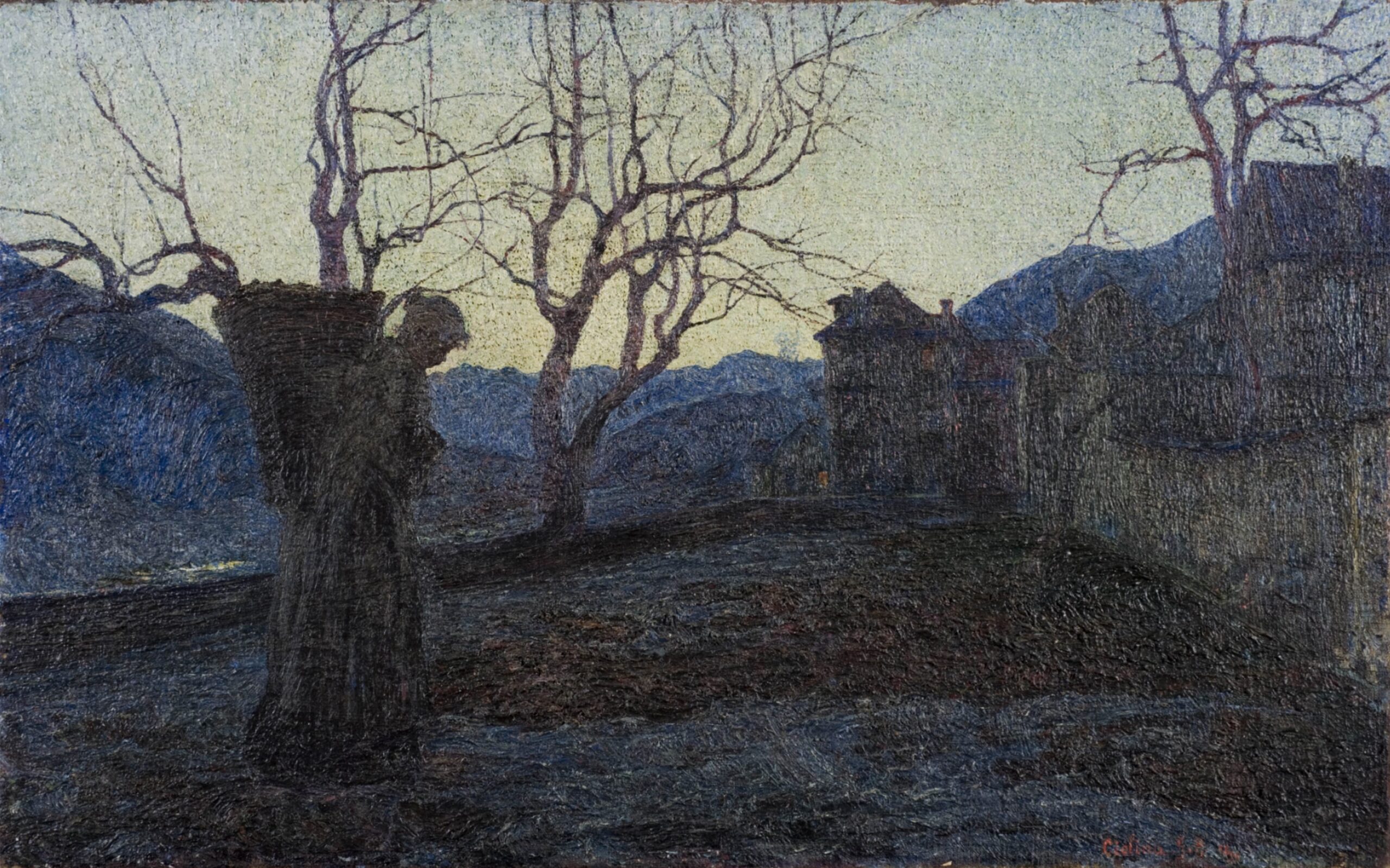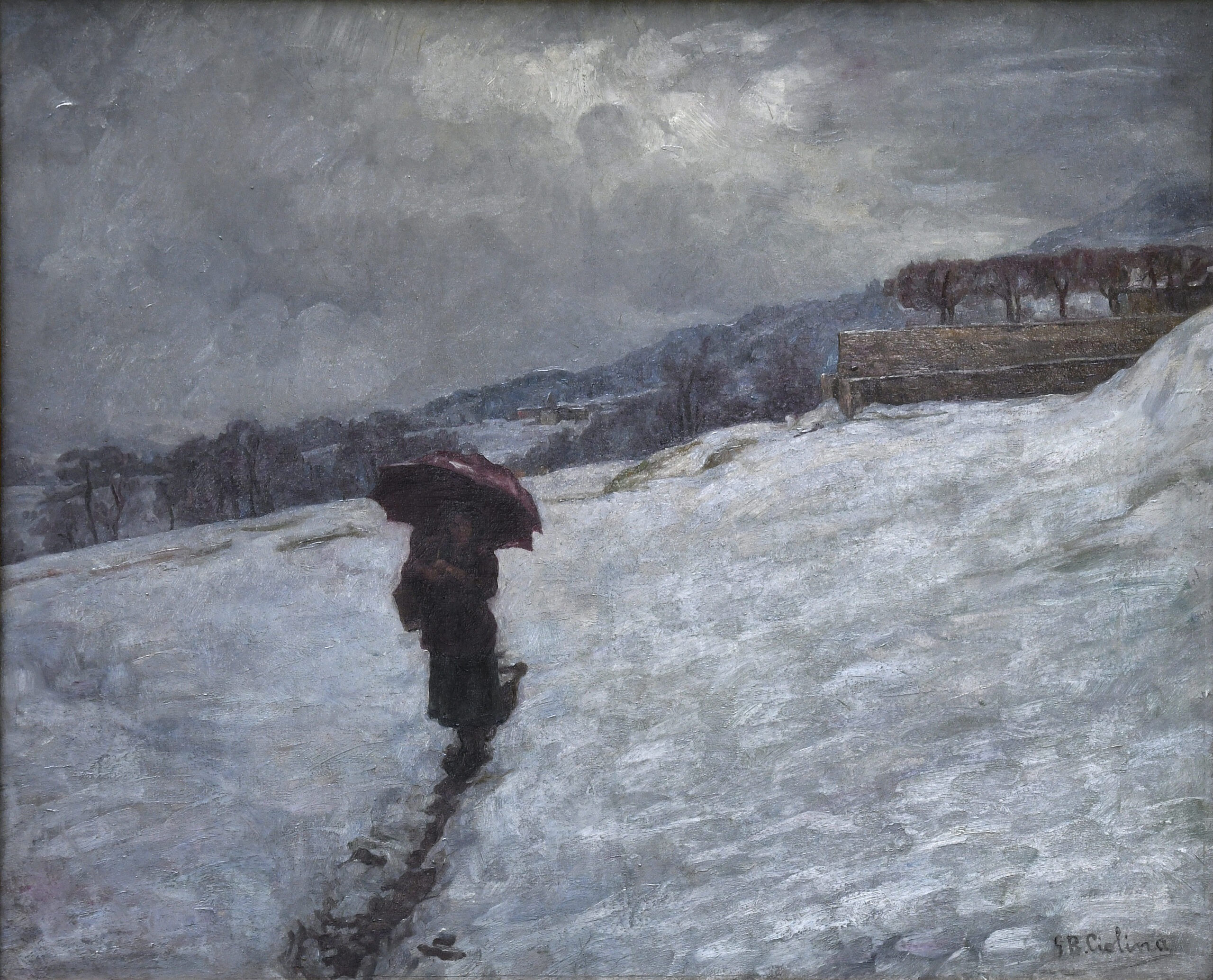Time should be considered with the utmost care because a day or an hour spent idly or engaged in unproductive work is irretrievably lost from life. Every morning, upon waking up, one must establish a strict schedule for the entire day and follow it with the utmost conscientiousness, so that when going to bed in the evening, one feels both fatigue and a sense of satisfaction that comes from fulfilling one’s duties with true scrupulousness. (…) One must be strong, always walking confidently on their own path in life, and even if the path becomes excessively rugged and frequent falls occur, one should not be discouraged. Instead, one must rise up more vigorous than before and continue on the journey as if nothing had happened.
June 1896. Giovanni Battista Ciolina’s diaries. Transcribed by Paolo Ciolina


CRITICAL ANALYSIS
A painter like Ciolina, who was trained at the Enrico Cavalli school where light and colour were central themes, and for whom landscape was a ‘pretext’ to experiment with infinite variations, could not resist the challenge of representing them when the sky is whitening in its last glimmers of light and can no longer capture the colours of reality, especially during winter. Among the most successful results of this challenge that he triumphantly overcame is Mestizia Crepuscolare, (Twilight Melancholy), one of the most poetic and engaging works by the artist from Toceno.
It stands as a one-of-a-kind piece in the national and international artistic landscape of those years, not only for its subject—the very last light of a clear winter sunset—but also for the unique technique developed by the painter. No photograph can faithfully capture this absolute masterpiece, which is a true symphony of cold colours—greys, blacks, purples, blues and glossy bitumen—enhanced by the imperceptible warm veil of the sky, which, in contrast, adds even more frigidity. Muted by the winter, all daylight colours disappear and merge into a bluish atmosphere that even softens the faint brown warmth of the piles of leaves, the woman’s basket in the foreground and the weak lights in the windows of distant houses.
And yet every square millimetre of the canvas vibrates as it would if it were representing a clear, backlit sunny day, except that here the light is completely absent! To achieve this effect, the entire surface of the painting is composed of a rough material, sometimes applied in filamented strokes, as seen in the mountains or the low wall on the left. Other times, it is achieved with short strokes, to produce dense ‘dots’ as seen clearly in the trees. Finally, the material is lumpy and thick in the sky and houses, creating deep voids or cavities where light does not penetrate. This makes the surface vibrate with an unexpected, unprecedented effect, producing the opposite result of how the Divisionists rendered light. Mestizia crepuscolare is not a Divisionist painting because the primary colour is not broken down or juxtaposed. However, the material is Divisionist,because through a mysterious and extraordinary alchemy, it preserves and conveys the last trace of colour.
Mestizia does not contain any symbolism: the bare trees do not carry the torment found in the Segantinian birch in Pastorella con pecora al Ranton(Shepherdess with Sheep in Ranton – tappa 2). The rigid figure of the woman in the foreground, which is paradoxically too large, does not have any hidden symbolism: she is instead an essential element of the human scene (houses, garden, walls…) and does not reject and condemn humans, like in Segantini’s Castigo delle lussuriose (The Punishment of Lust) or Cattive madri (The Bad Mothers). Rather, it asks for our participation and poetic involvement in the dying of the day and the suggestion of the cold, advancing night.
This woman’s role, her function, are the same as those of the female figure who, protected by a purplish parasol, walks down the snowy slope of the meadows just below the Toceno viewpoint in Crepuscolo invernale (Winter Twilight) from 1906. This is not broad daylight but rather sunset, darkened by the thick, dense clouds, which nevertheless allow the glimmer of the dying sun to shine through, to cast shadows over the woman’s figure.
It is an extremely unusual backlit scene, in which the female figure and the viewpoint wall emerge from a sea of greyish snow and are the only elements to receive light. The construction of the scene demonstrates exceptional skill. The diagonal composition of the incline and the mountains in the background adds a dynamism to the woman’s descent, creating a convincing portrayal of her struggle down the slope. The depiction of snow is no easy feat for a painter, especially when, as happens here, it is not clear daylight but rather the dark light of a gloomy sky where its sharpness must be calibrated. Ciolina also achieved these remarkable results in Inverno in Val Vigezzo (Winter in the Vigezzo Valley), produced for Senator Alfredo Falcioni during the same period.
Text and image research and adaptation by Chiara Besana.
Critical analysis by Paolo Volorio.
Sign up to receive news on events, exhibitions and trainings from the Rossetti Valentini School of Fine Arts Foundation.
Iscriviti per ricevere le news su eventi, mostre, incontri di formazione organizzati dalla Fondazione Scuola di Belle Arti Rossetti Valentini.